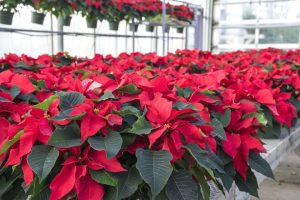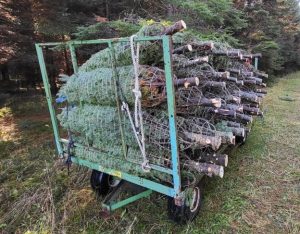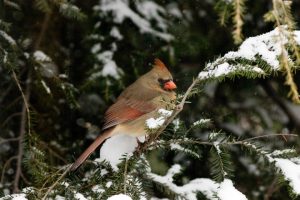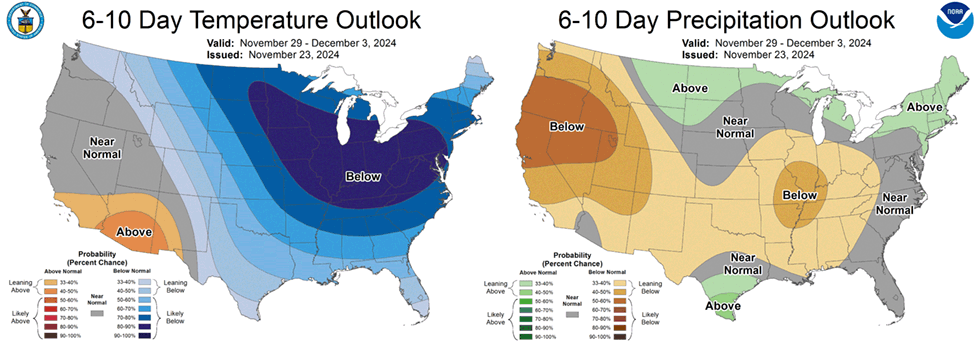
Maine Home Garden News – December 2024
In This Issue:
- December Is the Month to . . .
- A Note of Gratitude
- Holiday Gift Giving for Your Bee-Loved – A 2024 Gift Guide for the Pollinator-Friendly
- Send Holiday Cheer
- Give the Gift of Learning This Winter
- Backyard Bird of the Month: Northern Cardinal
- Maine Weather and Climate Overview
December Is the Month to . . .
By Kate Garland, Horticulturist
with special book club suggestion from Joyce Rumery, Master Gardener Volunteer

Keep tree stands filled with water. Give trees a fresh cut just before bringing them inside and check water levels daily. The Maine Christmas Tree Association offers a helpful list of other best practices for selecting and caring for natural trees during the holidays.
Give a homemade gift from the garden. Find inspiration from UMaine Cooperative Extension’s Food Safety team’s on-demand webinars Preserving the Maine Harvest: Gifts from the Kitchen. These webinars, from 2021 and 2022, feature several edible gift recipes and provide tips for giving food as gifts.
Treat yourself or a loved one to a poinsettia and help dispel the claim that they are poisonous. Learn more about traditional decorations that may or may not pose a risk to pets this holiday season.
Read about the natural world. Check with your library for book groups in your area or start your own. Some groups meet both in person and virtually so you can find a fit for your own schedule.

Protect newly purchased live plants from exposure to cold temperatures. Even a quick trip between the store and your vehicle can impact plant tissue on frigid days. Be sure to have tender plants wrapped or bagged before bringing them outside.
Sow native plant seeds in pots to store outside for the winter. Wild Seed Project, a Maine-based non-profit offers comprehensive instructions on their website and a wide selection of seeds for purchase. This easy and enjoyable activity keeps your fingers in the soil (a sure sign of a happy gardener) and can be a fun addition to seasonal celebrations with friends and family, such as Winter Solstice or New Year gatherings.
Make a drainage hole for any plants that come wrapped in foil. While the foil may look nice, water can accumulate and cause root rot if not managed properly. More information can be found in the University of New Hampshire Cooperative Extension’s bulletin Care of Flowering Gift Plants in the Home.
Stock up on carrots, winter squash, potatoes, garlic, apples and baked or canned goods at your local farmers’ market. Quality is key when it comes to cooking and nothing is better than locally-grown seasonal produce. The markets are still bountiful and the farmers are especially happy to see you this time of year. Here’s a recipe for some of the goodies you’ll find!
Share the gift of time. Winter can feel long for those of us who love being in the garden. Make plans to meet with gardening friends to browse seed catalogs, enjoy a cup of tea, sample a preserved treat from the garden, and share your gardening goals for the upcoming season. Connecting with others in this way can make a world of difference!
A Note of Gratitude
My two favorite teaching methods are exchanging tips and ideas while working alongside other gardeners and leading informal garden workshops that encourage meaningful dialogue with participants. The back-and-forth exchange between myself and learners (who often teach me as well) is what truly fulfills me as an educator.
Coordinating a newsletter is a distinctly different experience. There’s much less interaction with readers, which can leave me wondering if our resource is truly meeting the needs of Maine’s gardeners. Fortunately, your survey feedback has made it clear that our work is making a difference, and I am deeply grateful to those who took time to offer insights and suggestions for how we can continue to serve you in the future.
I’m also deeply grateful for the team behind the Maine Home Garden News. It takes a village to offer in-depth information on a wide range of topics and I always learn something new from our contributors. Please take a moment to read through the list of writers, editors, and support staff who helped create and distribute the 2024 Maine Home Garden News lineup.
Alex Gayton, Amy Witt, Andy Kapinos, Ankit K Singh, Anne Lichtenwalner, Barbara Harrity, Caragh Fitzgerald, Clarisa Diaz, Clara Ross, Coral Sheldon-Hess, Dixie Turner, Jonathan Foster, Kate Yerxa, Lynne Holland, Maine Audubon, Maine Department of Agriculture, Conservation and Forestry, Mary Kate Reny, Mary Michaud, Matt Thomas, Melissa Kim, Michelle Snowden, Naomi Jacobs, Pamela Hargest, Rebecca Long, Rebekah Mende, Richard Brzozowski, Sean Birkel, Shelby Hartin, Tony Sutton, Tori Jackson, Tricia Griffith, Viña Lindley, and Wendy Robertson.
Finally, don’t forget that we have a tremendous archive of articles for you to enjoy this winter while planning your 2025 horticultural adventures. Many of the articles you suggested in the feedback survey already exist! We’ll be taking January off to consider all your terrific suggestions as we develop the lineup for the coming year. If you appreciate our educational resources, consider a donation to our Horticulture Fund.
Wishing you a healthy holiday season full of good cheer,
Kate (on behalf of the Maine Home Garden News team)
Holiday Gift Giving for your Bee-Loved – A 2024 Gift Guide for the Pollinator-Friendly
By Mike Maberry, Penobscot County Master Gardener Volunteer
The gift giving season is upon us, and if you are like me, you are always seeking creative gifts for friends and family–especially the pollinator-friendly ones. There is no shortage of gift ideas and even ways to get younger family members involved in the giving.
For those who like garden accessories
A butterfly puddler is an attractive statement piece that improves butterflies’ breeding success by providing access to water as well as essential minerals and salts found in natural puddles. Creating a butterfly puddler can be an easy and affordable DIY project, perfect for doing with children. All you need is a shallow dish, some sand, and perhaps a few decorative rocks to make it visually appealing.
For those who want to show off a well-established pollinator friendly garden, consider a wonderful garden sign celebrating their efforts. Many can be found at local greenhouses or organizations that support wildlife conservation.
For those who can never have enough plants
We all know plant-lovers who continually add to their gardens and will be happy for new and unusual seeds. The Maine Audubon Plant Finder is a wonderful resource. You can search for plants that specifically benefit pollinators, among other categories.
If finding a source for unusual seeds seems daunting, the Wild Seed Project has you covered! The staff and volunteers of this Maine-based organization are dedicated to promoting organically grown and locally-sourced seeds. Their online catalog offers dozens of plants that support pollinators.
For those who appreciate the gift of new knowledge
Give yourself the gift of certifying your garden as pollinator-friendly. The Pollinator-Friendly Garden certification program through UMaine Cooperative Extension and University of New Hampshire Cooperative Extension is an educational experience where the application serves as a guide to best practices for creating an ecologically vibrant landscape.
Already have a certified Pollinator-Friendly Garden through our program? Look in your certification packet to learn how to order an official sign to celebrate your efforts and inspire others.
Consider classic books on ecological gardening, such as:
Attracting Native Pollinators: Protecting North America’s Bees and Butterflies
Doug Tallamy’s Bringing Nature Home: How Native Plants Sustain Wildlife in Our Gardens
Ellen Sousa’s The Green Garden: A New England Guide to Planting and Maintaining the Eco-Friendly Habitat Garden
Gifts like these will please your friends and family, whether they are just beginning to support pollinators or have extensive experience. I hope you find this guide helpful in your shopping this holiday season!
Send Holiday Cheer
By Maine Department of Agriculture, Conservation and Forestry staff
Send Holiday Cheer, Not Pests: Follow Out-Of-State Plant Health Regulations
Save time and money by sending healthy plant material and following the requirements for shipping and labeling.
Maine residents cherish their holiday traditions, and for many, decorating with Maine-grown wreaths, trees, and decorative flora is a special part of the season. Another annual holiday tradition is shipping Maine’s festive greenery to friends and family. When we do, it’s important to adhere to state laws and regulations to ensure the seamless transport of healthy plant materials, ultimately saving time, cutting costs, and preventing product loss.
“Shippers should be aware of the state laws and regulations regarding the movement of plants and forest products,” notes Carole Neil, Assistant Horticulturist with the Maine Department of Agriculture, Conservation and Forestry (DACF). “Many states closely monitor shipments to prevent the introduction of invasive insects and plant diseases. By planning, Maine shippers can speed up deliveries in this time-sensitive industry.”

DACF offers this advice for wreath and tree shippers:
- Import regulations vary from state to state. Check the regulations of your destination state before you send plant material; be aware that regulations may change from year to year. For example, Wisconsin imposes an elongate hemlock scale quarantine, and shipments from some parts of Maine are not allowed.
- Shipping internationally? Many countries prohibit plant material in holiday decorations. However, certain types may be allowed with the proper certification. Email horticulture@maine.gov for more information.
- Beware of invasive plants! Asiatic bittersweet and multiflora rose have attractive berries, but both are invasive and should never be included in holiday décor. Better choices for colorful berries include winterberry and holly.
- Look for pests. Carefully inspect plant material before packaging to ensure there are no insects, egg masses, or signs of pest damage.
- Clearly label packages. Begin with the statement “Grown in Maine,” followed by the county of origin and the name and address of the shipper. Indicate the specific types of greenery, nuts, fruits and cones that are included.
- Don’t forget about spongy moth! Spongy moth (Lymantria dispar, formerly known as gypsy moth) certification is required when sending plant material outside the quarantine area (Spongy Moth Quarantine). Contact the Maine USDA-Plant Protection Quarantine (PPQ) office at 207-848-0000 for more information.
“Import requirements for cut trees and holiday decorations including greenery, ornamental nuts, and fruit exist to protect regional agriculture and natural resources from the risk of plant pests,” explained Sarah Scally, Assistant Horticulturist with DACF. “An insect or plant disease appearing in Maine could be invasive in other states. Unfortunately, despite the quality of Maine products, some shippers have learned about these regulations the hard way and have had shipments delayed, impounded, or destroyed. We want to prevent any losses by getting the word out now.”
Shippers with questions are invited to call (207) 287-3891 or email horticulture@maine.gov. Media contacts: Sarah Scally, Jim Britt
Give the Gift of Learning
Know a gardener who needs something to do during Maine’s long dark winters? Our twelve On Demand Webinar bundles make great gifts for a beloved gardener in your life.
Each bundle includes 3 to 4 pre-recorded webinars (60 to 75 minutes each) on a gardening-related topic plus a list of related resources.
For the perennial gardener:
For the culinary gardener:
- Unique Crops: Mushrooms, Microgreens, and Fiddleheads
- Unique Fruits for Maine: Cranberries, Blueberries, and More
- Home Orchard
- Vegetables and Vine Fruits
For any gardener looking to level up their skills:
For the creative and adventurous gardener:
To purchase a bundle for yourself, follow the registration link under each bundle description. To gift a bundle, use our “Gift a Bundle” registration page to select a bundle and your recipient.
We’ll email the bundle to your recipient and let them know it is a gift from you. As a bonus you will also receive a copy of the bundle so you can see what they received. If you have any questions, reach out to extension.gardening@maine.edu.
Thank you to everyone who provided feedback through the Maine Home Garden News reader survey. The top three gardening topics you voted for were native plants, soil health and climate change. Keep your eyes out in 2025 for more programs on these topics!
Backyard Bird of the Month: Northern Cardinal
By Andy Kapinos, Maine Audubon Field Naturalist

The vibrant red plumage of Northern Cardinals is always a welcome sight on a cold day. Northern Cardinals molt their feathers once per year, usually in August or September, after nesting and before winter. To regrow their bright red feathers, they must eat fruits (and insects) high in carotenoids, pigments that give many plants and animals their red, orange, and yellow colors. Cardinals get these pigments from the fruits of plants like honeysuckles, sumacs, and their favorite, wild grapes. In a study of molting Northern Cardinals in Ohio, fruit made up nearly 60% of the diet, with more than half of that being wild grapes. They are even capable of peeling grapes with their beak before eating the pulp and seeds. Though they also eat the fruits of many invasive plant species, like Multiflora Rose and Asiatic Bittersweet, they may actually help slow their spread: Northern Cardinals generally chew seeds up with their bill, so the seeds are not viable after they pass through the digestive system. Take a moment the next time you see a cardinal to observe how easily they crush through seeds with their massive, highly-adapted orange beaks, which also get their color from the carotenoids in their diet.
Maine Weather and Climate Overview
Dr. Sean Birkel, Assistant Extension Professor, Maine State Climatologist, Climate Change Institute, Cooperative Extension University of Maine
Maine statewide temperature and precipitation summaries from NOAA rank October 2024 as 16th warmest (top 1/3) and 14th driest (bottom 1/3) for records beginning 1895. November has also been very warm and dry for this time of year, and daily station observations from Bangor, Caribou, and Portland (Nov 1–24) suggest the month could rank among the three warmest and top five or six for driest. Since mid August, high pressure systems have repeatedly formed across the northeastern U.S., reducing the ability for storms to bring moisture into the region. As a result, moderate drought has developed across much of Maine with year-to-date rainfall deficits ranging 2–6 inches from normal, leading to low streamflows and groundwater. Recent beneficial rainfall Nov 22–23 has moistened soils and provided a modest hydrologic input. The current 10-day forecast shows a more active weather pattern with one or two storms that could deliver more beneficial precipitation. Whether some amount hydrologic drought persists through winter depends on the rainfall accumulation before temperatures drop and the ground freezes.
| Product | Temperature | Precipitation |
|---|---|---|
| Days 6-10: Nov, 29 – Dec 3 (issued Nov 23) | Below Normal | Above Normal |
| Weeks 8-14: Dec 1 -7 (issued Nov 23) | Below Normal | Below Normal |
| Monthly, December (issued Nov 21) | Equal Chances | Equal Chances |
| Seasonal: Dec-Jan-Feb (issued Nov 21) | Above Normal | Equal Chances |

For questions about climate and weather, please contact the Maine Climate Office.
Do you appreciate the work we are doing?
Consider making a contribution to the Maine Master Gardener Development Fund. Your dollars will support and expand Master Gardener Volunteer community outreach across Maine.
Your feedback is important to us!
We appreciate your feedback and ideas for future Maine Home Garden News topics. We look forward to sharing new information and inspiration in future issues.
Subscribe to Maine Home Garden News
Let us know if you would like to be notified when new issues are posted. To receive e-mail notifications, click on the Subscribe button below.
University of Maine Cooperative Extension’s Maine Home Garden News is designed to equip home gardeners with practical, timely information.
For more information or questions, contact Kate Garland at katherine.garland@maine.edu or 1.800.287.1485 (in Maine).
Visit our Archives to see past issues.
Maine Home Garden News was created in response to a continued increase in requests for information on gardening and includes timely and seasonal tips, as well as research-based articles on all aspects of gardening. Articles are written by UMaine Extension specialists, educators, and horticulture professionals, as well as Master Gardener Volunteers from around Maine. The following staff and volunteer team take great care editing content, designing the web and email platforms, maintaining email lists, and getting hard copies mailed to those who don’t have access to the internet: Abby Zelz*, Annika Schmidt*, Barbara Harrity*, Kate Garland, Mary Michaud, Michelle Snowden, Naomi Jacobs*, Phoebe Call*, and Wendy Robertson.
*Master Gardener Volunteers
Information in this publication is provided purely for educational purposes. No responsibility is assumed for any problems associated with the use of products or services mentioned. No endorsement of products or companies is intended, nor is criticism of unnamed products or companies implied.
© 2023
Call 800.287.0274 (in Maine), or 207.581.3188, for information on publications and program offerings from University of Maine Cooperative Extension, or visit extension.umaine.edu.

